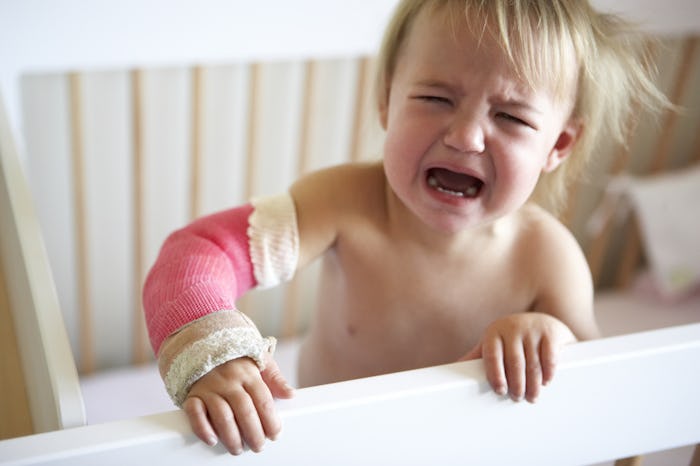Life

7 Signs Your Baby Has A Broken Bone
The thought of your baby getting hurt is overwhelming and scary. Unfortunately, it happens, especially once they're mobile. The trouble with babies, however, is that they can't tell you what happened or what hurts, so you have to ask yourself if you should call the doctor, take them to the Emergency Room, or wait and see. It's difficult to tell what's wrong when your child isn't verbal, so it's natural to wonder how to tell if your baby has a broken bone. Thankfully, there are some red flags you can look out for so you can either get them help as soon as possible, or avoid an unnecessary trip to the hospital.
According to the American Academy of Pediatrics's (AAP) website, Healthychildren.org, broken bones are one of the most common forms of injury in children under 6. Fortunately, the same site notes that kids are pretty damn resilient, and can heal quickly once a break is identified and treated. But when your kid is constantly falling down and getting hurt, as kids are known to do, it can be difficult to differentiate a potentially serious injury from just another bump or bruise. Fortunately, for worried parents everywhere, you can figure out if it's a break right away if you simply know what to look for.
According to Caryl Waite, PA-C, a physician assistant with Mount Nittany Physician Group Pediatrics, you can tell a lot about an injury from where it's at. Most broken bones generally happen in the middle of limbs and away from joints. And according to BabyCenter, a broken bone will cause swelling and pain, but unlike other types of injuries, won't respond to rest and ice. The same site notes that your baby might tell you it hurts by not using or putting pressure on the afflicted area, or crying when it is touched. However, your baby may still be able to move a broken bone, so it's best to get care from a medical professional if you suspect a break.
You Heard It Happen
According to BabyCenter, you can actually hear bones break if you are present when an injury occurs. If your baby's fall or accident resulted in a snapping sound, it's best to get them evaluated for a possible broken bone.
It Doesn't Look Right
Waite adds that other obvious sign of a broken bone are physical changes that you can see or feel. BabyCenter adds that if it looks like the bone is out of place or bent in a way it shouldn't bend, that is a clear sign of a break.
They Are In Pain
Seeing your child in pain is the worst. According to BabyCenter, if their pain is severe, isolated to a spot, and gets worse if you touch or move the affected limb, your baby might have a broken bone and should be evaluated by a doctor as soon as possible.
The Injury Isn't Near A Joint
Location is often your first clue to the nature of an injury, as Waite writes for Mount Nittany Physician Group Pediatrics. If your child has swelling and pain near a joint, it's probably not a broken bone. Breaks, on the other hand, usually occur away from joints in the middle of the bone.
Swelling & Bruising
Babies and toddlers seem to have a knack for getting bruises, and unfortunately, according to Waite, many different injuries can cause swelling and bruising, so the two aren't always a sign of a broken bone. According to Healthychildren.org, it's important to pay attention to how your child acts. "Ordinarily with a fracture, you will see swelling and your child will clearly be in pain and unable—or unwilling—to move the injured limb."
They Avoid Using That Body Part
Waite adds that it can be hard to tell if an injury is a break or a sprain. However, she writes, "If the child is unable to bear weight on the injured leg or unable to have any use of an upper body part, that increases the likelihood of a fracture." So, if they are running or crawling again after some snuggles, you can probably rest easy.
It Doesn't Improve
According to BabyCenter, with your doctor's approval, you might give your baby and over-the-counter pain medication, like ibuprofen or acetaminophen, and use ice packs and elevation to help them get comfortable. They caution parents to call 9-11 and not move your baby if you suspect a injury to their skull, back, or pelvis.
For other areas of the body, if your baby's pain and swelling improve with rest and ice, it's likely not a broken bone. But, if they do not get better, or get worse, you should definitely call your baby's doctor and ask if you should bring them in or to the Emergency Room for treatment.
Check out Romper's new video series, Bearing The Motherload, where disagreeing parents from different sides of an issue sit down with a mediator and talk about how to support (and not judge) each other’s parenting perspectives. New episodes air Mondays on Facebook.